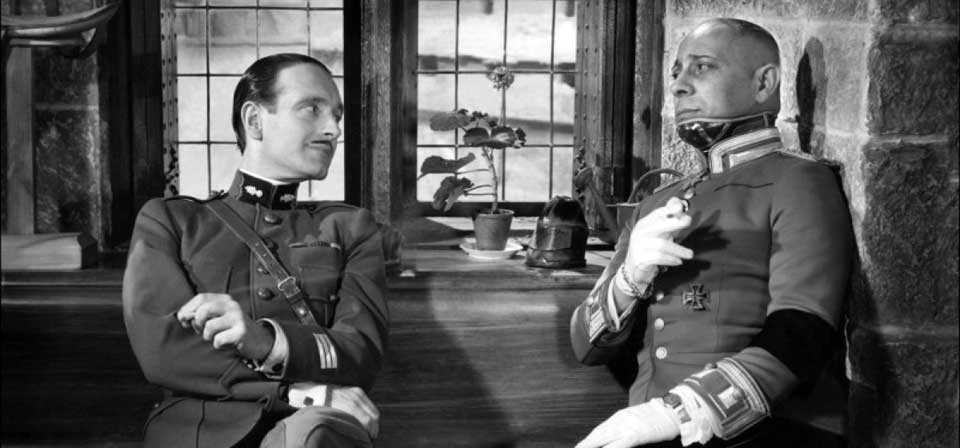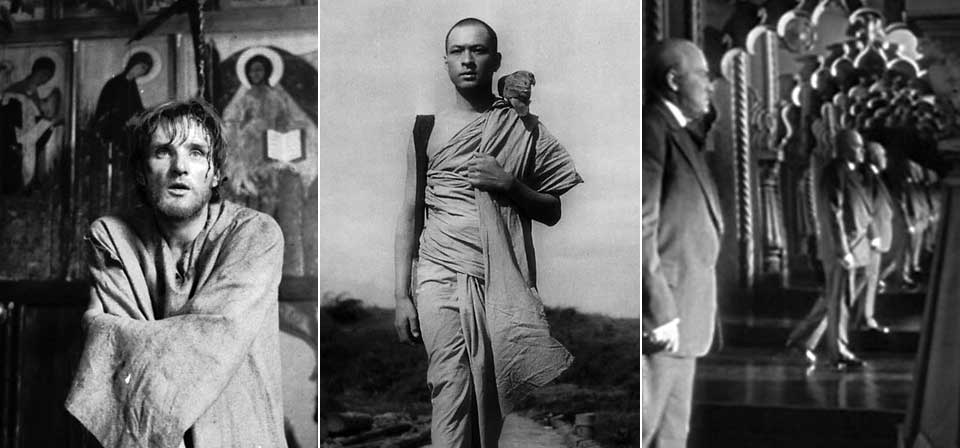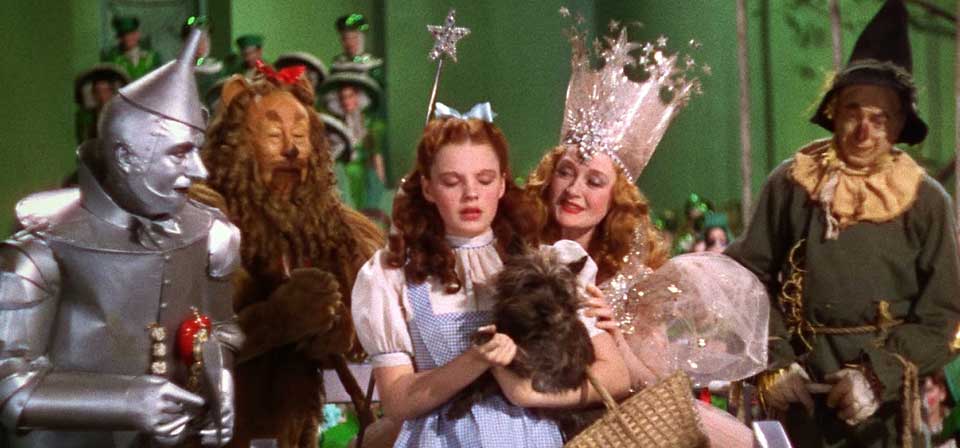Tags :: Vatican Film List: Art

Grand Illusion (1937)
Asked what he was trying to do in Rules, Renoir is reported to have said, “I don’t care.” With Grand Illusion, it may not be much easier to say what he’s trying to accomplish, but there is no doubt that he cares.

The Leopard (1963)
One comes, like these Redshirts, as a cultural sightseer to The Leopard, with its palatial grandeur, replete with lavish, painterly images of the bygone glory of the Italian aristocracy: already in their own day semi-mythological figures, as we see in a vignette in which Father Pirrone, tries to explain to the common people the mysterious ways of the nobility: “They live in a world apart, not created by God, but by themselves.”
The Wizard of Oz [video]
Digitally remastered from the original negatives, painstakingly restored, The Wizard of Oz celebrates its 75th anniversary in style. Here’s my “Reel Faith” 60-second tribute to this beloved classic.
Over the Rainbow: The Wizard of Oz Turns 75
So many songs about rainbows and what’s on the other side? What was Kermit talking about? There’s only one song like that … and one movie that embodies the childhood magic Jim Henson wanted to evoke.

Citizen Kane, André Bazin and the “Holy Moment”
Everyone knows that Citizen Kane — celebrating its 70th anniversary with this week’s 3-disc Blu-ray debut — enjoys a bulletproof reputation as The Greatest Movie Ever Made … What isn’t so generally known is that the film’s prominent place in so many film classes — and for that matter, the fact that there are film classes in the first place — has a lot to do with the work of a revolutionary Catholic film critic and theorist, André Bazin, whose critical theories were shaped by the same tradition of Christian personalist philosophy that informed the writings of Pope John Paul II.
Fantasia and Fantasia 2000: Revisiting the Sistine Chapel of Disney Animation
(Newly available on Blu-ray/DVD) Rather than a static motion picture, Fantasia was originally conceived as a repertoire, a selection of presentations that over time could be augmented by new pieces while old ones were retired, like an orchestra rotating its concert lineup … Ten years ago, amid the wreckage at the end of the 1990s Disney Renaissance, the Disney studio marked Fantasia’s 60th anniversary with Fantasia 2000, a film intended to honor in a way the original repertory conception of Fantasia.

The Vatican Film List
The pope’s remarks were both forward looking, speaking to the potential of cinema to become “a more and more positive factor in the development of individuals and a stimulus for the conscience of society as a whole,” and also historically minded, speaking positively of the praiseworthy contributions of “many worthwhile productions during the first hundred years of [the cinema’s] existence.”
Napoléon (1927)
It is an extraordinary artifact from another culture, a mythology as remarkable and as alien as the Epic of Gilgamesh or the Icelandic Eddas. For students of silent film, this is one of those indispensable landmarks you must see before you die.
La Strada (1954)
As yet, I have found no illumination in critical accolades and explanations. No critical account of La Strada I have read has struck me as compelling or illuminating. Pauline Kael famously wrote that the three main characters represent the flesh, the spirit, and the mind. But the same could be said for virtually any trinity of characters, from Lancelot, Arthur, and Guinevere to Kirk, Spock and McCoy to Mr. Toad, Mole, and Rat, and what light this paradigm sheds on this particular story is unclear to me. Alan Stone calls it "a parable about Italy under fascism and the possibility of Christian Salvation," but I can’t see that it has anything interesting to say about this either, or that it says it in an interesting way.
8½ (1963)
Though more of a Fellini skeptic than not myself, I can’t go along with the common opinion that Fellini’s early neorealist-inflected works, culminating in La Strada, are his best, and that the later, increasingly surreal cinema of the gaudy and fantastical represented by 8½; is self-indulgently trivial by comparison.
Metropolis (1927)
Surreal, sprawling, and operatic, drawing on biblical and medieval Christian imagery as well as H. G. Wells’s The Time Machine, Fritz Lang’s deeply influential pulp allegory Metropolis colonized a new realm of the imagination that has shaped subsequent science fiction from Flash Gordon to Star Wars, from "The Jetsons" to Blade Runner.
2001: A Space Odyssey (1968)
2001: A Space Odyssey doesn’t just depict a quantum leap forward in human consciousness — it practically requires such a leap, on an individual scale, from the viewer. Like the hominid in the first act who looks at a bone and suddenly sees what no hominid has ever seen before, one must watch 2001 in a different way from other films.
Stagecoach (1939)
Stagecoach is not the greatest Western of all time, but has been called the first great Western, and played a key role in the status of the Western as the quintessential American genre.
The Lavender Hill Mob (1951)
Much of the comedy comes from reversal of stereotypes, with the mild-mannered, middle-class Holland aspiring to the role of criminal mastermind, and Holland’s elderly landlady (Edie Martin) knowledgeably conversing with bemused bobbies in street slang learned from dime-store crime fiction. And while the caper-gone-wrong comedy genre has been done to death in recent decades, The Lavender Hill Mob avoids most of what became the clichés of the genre.

Citizen Kane (1941)
While working on Citizen Kane, Welles joked that "If they ever let me do a second picture, I’m lucky." He was only half right. He was lucky enough to make many additional pictures, some of them masterpieces in their own right. But the luckiest he ever got, which is more than lucky enough, was getting to make Citizen Kane itself. That unprecedented level of control and magical synergy was a once-in-a-lifetime opportunity — and, to his immortal credit, Welles made the most of it. He made Citizen Kane.
Little Women (1933)
Part comedy of manners, part morality tale, it’s more interested in its heroines “conquering themselves” than in a man conquering their hearts.
Nosferatu: A Symphony of Horror (1922)
Though diminished by decades of pop-horror incarnations, the vampire remains uniquely evocative of both dread and fascination, horror and seductiveness. Monsters from werewolves to Freddy Krueger may frighten, but neither victims nor audience are drawn to them. By contrast, the vampire suggests the horror of evil working on our disordered passions.

Modern Times (1936)
Silent films were already old-fashioned and out of vogue in 1936 when Charlie Chaplin completed his last silent feature film, Modern Times, almost ten years after the sound revolution began with The Jazz Singer. A silent film consciously made for the sound era, Modern Times is a comic masterpiece that remains approachable today even for movie lovers raised on computer imaging and surround sound.

Fantasia (1940)
If Fantasia failed to spark a hoped-for entertainment revolution, its achievement is all the more starkly singular. A joyous experiment in pure animation, an ambitious work of imaginative power, a showcase of cutting-edge technique, and a celebration of great music, it is without precedent and without rival. I’ve watched it far too many times to count, and I have yet to begin tiring of it.

The Wizard of Oz (1939)
The Wizard of Oz is one of a very few shared experiences that unite Americans as a culture, transcending barriers of age, locale, politics, religion, and so on. We all see it when we are young, and it leaves an indelible mark on our imaginations. We can hardly imagine not knowing it. It ranks among our earliest and most defining experiences of wonder and of fear, of fairy-tale joys and terrors, of the lure of the exotic and the comfort of home.
Recent
- Benoit Blanc goes to church: Mysteries and faith in Wake Up Dead Man
- Are there too many Jesus movies?
- Antidote to the digital revolution: Carlo Acutis: Roadmap to Reality
- “Not I, But God”: Interview with Carlo Acutis: Roadmap to Reality director Tim Moriarty
- Gunn’s Superman is silly and sincere, and that’s good. It could be smarter.
Home Video
Copyright © 2000– Steven D. Greydanus. All rights reserved.